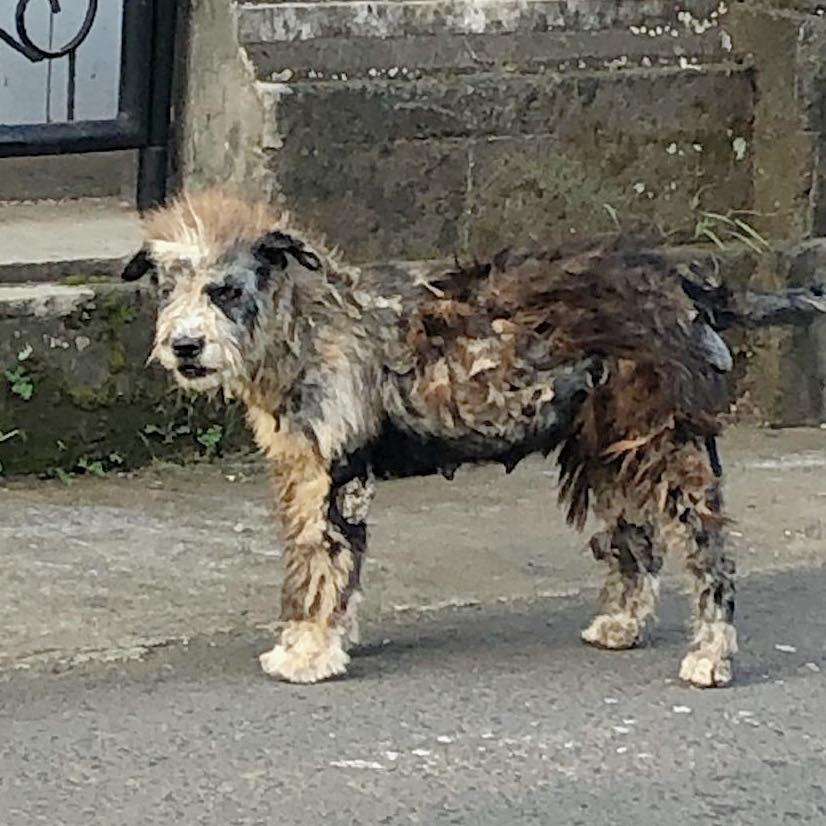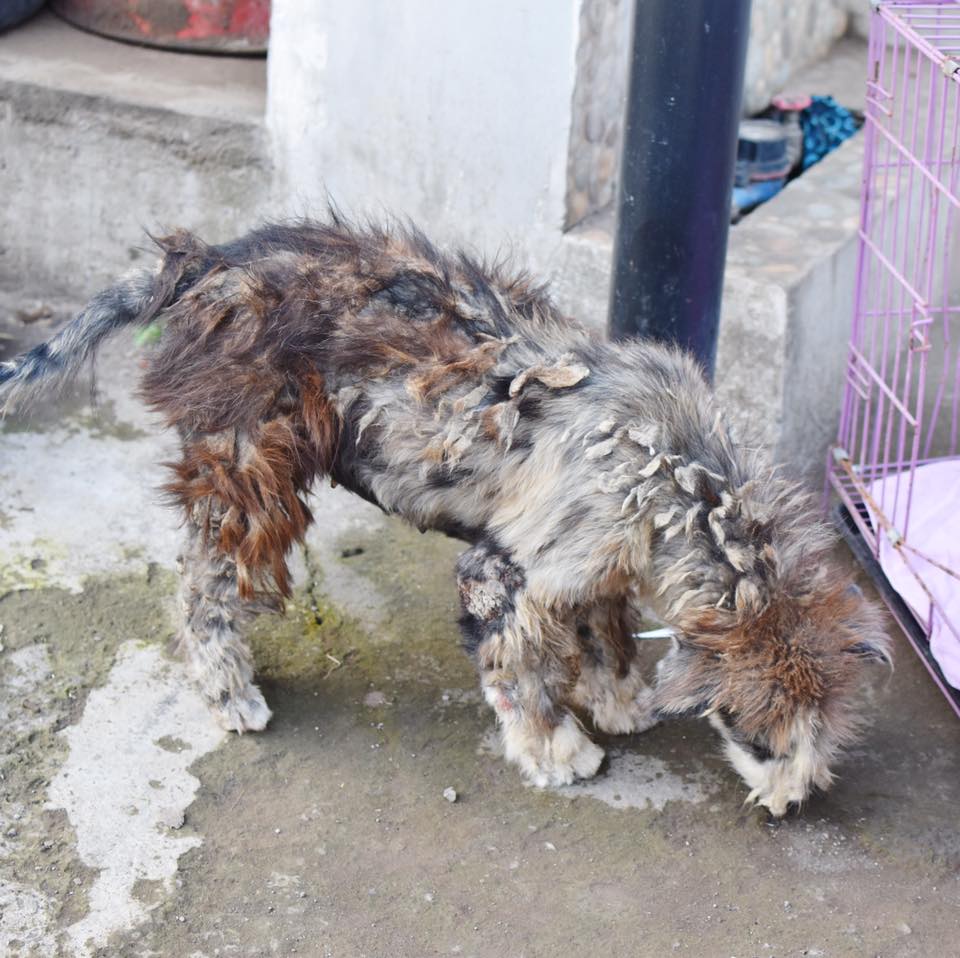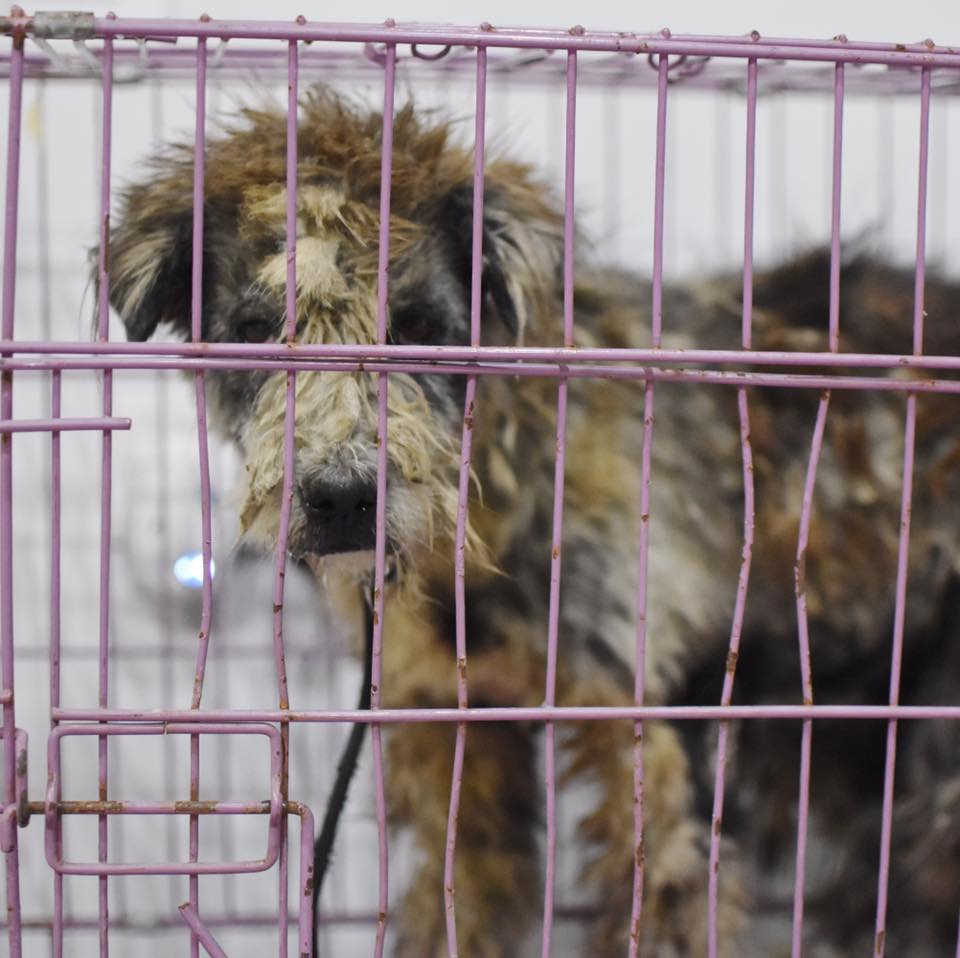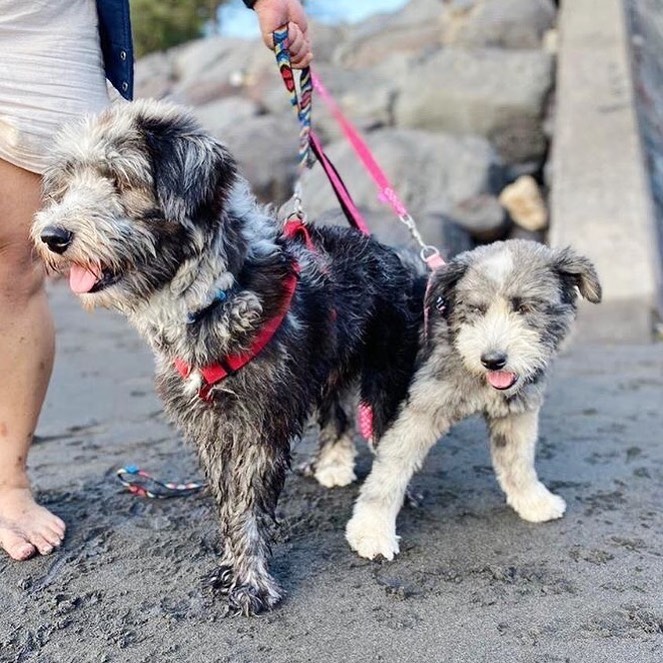A kind-hearted man named Jace was riding his bike to a basketball game when he suddenly spotted a heartbreaking sight on the side of the road.
It was a small dog in horrible condition with noticeable wounds on her little body.
She needed rescuing urgently, but this kind man was unable to rescue her immediately. He couldn’t just leave her there, so he made a couple of calls and organized for someone to come pick her up.
Thanks to his compassionate act, the course of this little dog’s life was forever altered.
Rescuing The Sweet Little Girl

Jace called his mom, who then brought the Mission Pawsible animal rescue team with her to help rescue this precious pup.
The little girl was sleeping in her corner, but as soon as these strangers started approaching her, she let them know not to come close.
She was very scared of humans, but they were determined not to leave her behind, so they initiated a rescue plan.
First, they started to ask around and try to locate where exactly she lived or if she had an owner. They were horrified to find out that this dog actually had someone she belonged to, despite her horrible condition.

“She was once a stunning western breed puppy but she wasn’t maintained to the standard of care these animals require so today she is covered in dreadlocks, ticks, fleas and is fearful of most people. This is why people need to be educated around pet care – both physically and mentally,” Mission Pawsible wrote in their Facebook post.
She probably never had a bath in her whole life, nor the right person who would take proper care of her.
The rescuers first tried to lure her in a cage with some food, but she was way too smart for that.
After thirty minutes of trying to coax her, the ‘owner’ arrived on a scooter and was able to put a leash on her.

“The ‘owner’ agreed for us to take her. The sadness and confusion in Lexie’s eyes was heartbreaking. Removing owned animals from their humans is truly a horrible experience. She may have dreadlocks and been neglected but she still loves that man,” the rescue wrote.
She was very distraught, but eventually calmed down because in a way, she must have known that they were finally going to help her.
The Start Of A New And Beautiful Life

She was transported to a veterinary clinic, where she enjoyed a haircut and some delicious food.
After the shave, they were able to fully assess the state of her cuts and injuries, but thankfully, they were minimal in the end.
Unfortunately, she was still heartbroken and a bit depressed, but the staff at the veterinary clinic made it clear that she could push through her sadness and learn to trust once again.
She just needed the right foster home or a forever home that would allow this pretty girl, now named Lexie, to decompress and slowly build trust.
Thankfully, Lexie found a new home quickly, and her new mom was an ideal match for her.
Her new mom, Michellina Suminto, fell in love with her at first sight. She was actually looking for another puppy to adopt because her other dog needed a friend.

Meanwhile, Lexie had transformed into an incredibly fluffy ball of fur once her coat had regrown, and she was the cutest dog ever.
In just a matter of days, Lexie and her adoptive brother, Edison, became inseparable.
“She is such a brave girl now, I am so proud of her,” Michellina told The Dodo.
Lexie is not scared of humans anymore, all thanks to one kind soul who showed her the true meaning of love.
Ever wondered about the fascinating correlation between dog years and human years? As a seasoned dog trainer, you’re likely familiar with the concept that one human year doesn’t equate to a simple seven dog years. The relationship between the aging processes of dogs and humans is a topic that sparks curiosity and discussion among pet owners and enthusiasts alike. Understanding the conversion of time in terms of canine and human years adds an intriguing layer to the bond we share with our furry companions.
When you think about your loyal canine companion, it’s natural to ponder how their age aligns with our own. The calculation of dog years to human years goes beyond a mere numerical comparison, delving into the realms of biology, behavior, and care. Stay tuned as we unravel the secrets behind the age-old question of how many dog years truly make up one human year.
Exploring the Aging Process
Understanding the aging process in dogs and humans can provide valuable insights into how they age differently. Here’s a breakdown to shed light on this fascinating aspect:
Dog Years vs. Human Years
Exploring the concept of dog years versus human years reveals that the idea of one dog year equating to seven human years is oversimplified. The relationship between dog and human aging is more complex than commonly believed.
Factors Influencing Aging
Several factors influence how dogs and humans age, including genetics, size, and breed. These variables contribute to variations in the aging process, making it challenging to establish a direct correlation between dog and human years.
Comparing Lifespans
While dogs generally have shorter lifespans than humans, the rate at which they age differs. Small dogs tend to mature faster and live longer compared to larger breeds. Understanding these differences can help in providing appropriate care for dogs at different stages of their lives.
Health and Aging
Health plays a crucial role in the aging process for both dogs and humans. Regular veterinary check-ups, proper nutrition, exercise, and mental stimulation are vital for maintaining optimal health and ensuring a good quality of life as they age.
Age-Related Changes
As dogs and humans age, they experience changes in their physical and cognitive abilities. Recognizing and addressing these age-related changes promptly can help in managing potential health issues and ensuring the well-being of your canine companion.
Conclusion
Understanding the nuances of dog and human aging processes can deepen your bond with your furry friend. By being aware of the factors influencing aging, comparing lifespans, prioritizing health, and addressing age-related changes, you can ensure a happy and healthy life for your beloved pet.
Understanding Dog Years and Human Years
When it comes to understanding dog years and human years, the popular belief that one dog year is equivalent to seven human years is not entirely accurate. Dogs age at different rates based on their size and breed, making a direct conversion challenging. So, how can you estimate your furry friend’s age in human years? Let’s break it down:
Factors Influencing Aging Rates
Factors like genetics, size, and breed play crucial roles in how dogs age. Smaller dogs tend to mature faster and live longer than larger breeds. Genetics also play a significant part in determining a dog’s lifespan and how they age over time.
Calculating Dog Years
To get a rough idea of your dog’s age in human years, consider the following general guideline:
- Small breeds (under 20 pounds): A one-year-old small dog is roughly equivalent to a 15-year-old human.
- Medium breeds (21-50 pounds): A one-year-old medium-sized dog is similar to a 10–13-year-old human.
- Large breeds (over 50 pounds): A one-year-old large dog corresponds to a 7–8-year-old human.
Importance of Age-Appropriate Care
Understanding your dog’s age in human years can help tailor their care needs accordingly. Just like humans, dogs require different care as they age. Regular veterinary check-ups, proper nutrition, exercise, and mental stimulation are vital for ensuring a happy and healthy life for your canine companion at every stage of their life.
Factors Affecting Aging Rates in Dogs and Humans
Genetics:
Genetics play a crucial role in determining the aging rates of both dogs and humans. Just like in humans, dogs inherit certain genetic traits that can influence their lifespan and how they age. Genetic factors can impact a dog’s susceptibility to certain diseases and overall health as they grow older.
Size and Breed:
The size and breed of a dog are significant factors that affect how quickly they age. Smaller breeds tend to mature faster than larger breeds, reaching adulthood sooner. Additionally, certain breeds are predisposed to specific health issues that can impact their aging process. Understanding your dog’s breed characteristics can help tailor their care to meet their unique needs.
Lifestyle and Environment:
The lifestyle and environment in which a dog lives can also impact their aging process. Factors such as diet, exercise, living conditions, and mental stimulation all play a role in determining how well a dog ages. Providing a healthy and stimulating environment, along with proper nutrition and regular exercise, can contribute to a longer and healthier life for your canine companion.
Veterinary Care:
Regular veterinary check-ups are essential for monitoring your dog’s health and addressing any issues that may arise with aging. Veterinarians can provide guidance on preventive care, early detection of diseases, and managing age-related conditions. Ensuring that your dog receives proper medical attention can help maintain their quality of life as they age.
Conclusion:
Genetics, size and breed, lifestyle and environment, and veterinary care are key factors that influence the aging rates of dogs and humans. By understanding these factors and providing tailored care for your furry friend, you can help ensure that they lead a happy and healthy life at every stage of aging._considered when determining how quickly your dog ages.
Scientific Studies and Research Findings
When it comes to understanding the aging process of dogs compared to humans, scientific studies have provided valuable insights that debunk the common myth of a 1:7 ratio between dog years and human years. Instead, researchers have uncovered more complex factors that influence the aging rates of both dogs and humans.
- Genetic Influence:
Genetic makeup plays a crucial role in determining the lifespan and health of dogs and humans alike. It affects their susceptibility to diseases and overall aging process. - Size and Breed Impact:
The size and breed of a dog can significantly impact how quickly they age. Smaller breeds tend to mature faster compared to larger breeds, highlighting the importance of considering these factors when assessing age-related issues. - Lifestyle Factors:
As with humans, a dog’s lifestyle has a direct impact on how they age. Factors such as diet, exercise, mental stimulation, and overall care play a vital role in promoting healthy aging in dogs. - Importance of Veterinary Check-ups:
Regular veterinary check-ups are essential for monitoring a dog’s health status, addressing any age-related concerns, and ensuring they receive appropriate care tailored to their individual needs.
By understanding and addressing these key factors identified through scientific research, you can better care for your furry companion and help them lead a happy and healthy life at every stage of aging.
Common Myths and Misconceptions
Some common misconceptions about dog years and human years may lead to misunderstandings about our furry friends’ aging processes. Here are a few myths debunked:
- 1:7 Ratio: One prevalent myth suggests that one dog year is equal to seven human years. However, this oversimplified ratio doesn’t accurately reflect the complex aging dynamics between dogs and humans.
- Age Equivalence: Another misconception revolves around age equivalence, assuming that dogs age similarly to humans at each stage of life. In reality, dogs’ aging rates vary based on factors like breed, size, genetics, and overall health.
- Linear Aging: Some believe that both dogs and humans age linearly, with each year corresponding to a set amount of time. The truth is that aging is nonlinear for both species, influenced by genetic and environmental factors.
- Age-related Milestones: It’s not accurate to assign specific age-related milestones to dogs based solely on human standards. Dogs may reach maturity at different ages depending on their breed and size.
Understanding these myths and misconceptions can help you appreciate the unique aging process of your canine companion and adapt your care practices accordingly.
Conclusion
That’s the scoop on dog years versus human years! Remember, it’s not as simple as a 1:7 ratio. Genetics, size, breed, lifestyle, and environment all play a role in how dogs and humans age. Small breeds may mature faster, and factors like diet, exercise, and vet visits are key for healthy aging. Don’t fall for common myths – age equivalence, linear aging, and age-related milestones can vary widely. By understanding these misconceptions, you can better care for your furry friend as they age. Keep these insights in mind as you cherish every moment with your canine companion!
Frequently Asked Questions
How do genetics play a role in dog aging compared to human aging?
Genetics significantly influence aging rates in dogs and humans. Smaller breeds tend to mature faster and have longer life spans compared to larger breeds. Genetic factors also impact disease susceptibility and overall lifespan.
Why is diet and exercise crucial for healthy dog aging?
Diet and exercise play a crucial role in ensuring healthy aging for dogs. A balanced diet and regular exercise regimen help maintain optimal weight, muscle mass, and overall well-being, reducing the risk of age-related issues.
What common myths and misconceptions exist about dog aging?
Common myths include the 1:7 ratio equating dog years to human years, linear aging assumptions, and misunderstandings about age-related milestones. Understanding these myths helps owners appreciate their dog’s unique aging process.
[no_toc]

Hey there, I’m Janet Brooks, a dog-loving student from California. I’m all about helping pups in need, especially those without homes. Me and my awesome friends work together to give shelter and love to stray dogs. Oh, and I also write blogs about dogs to share helpful info.